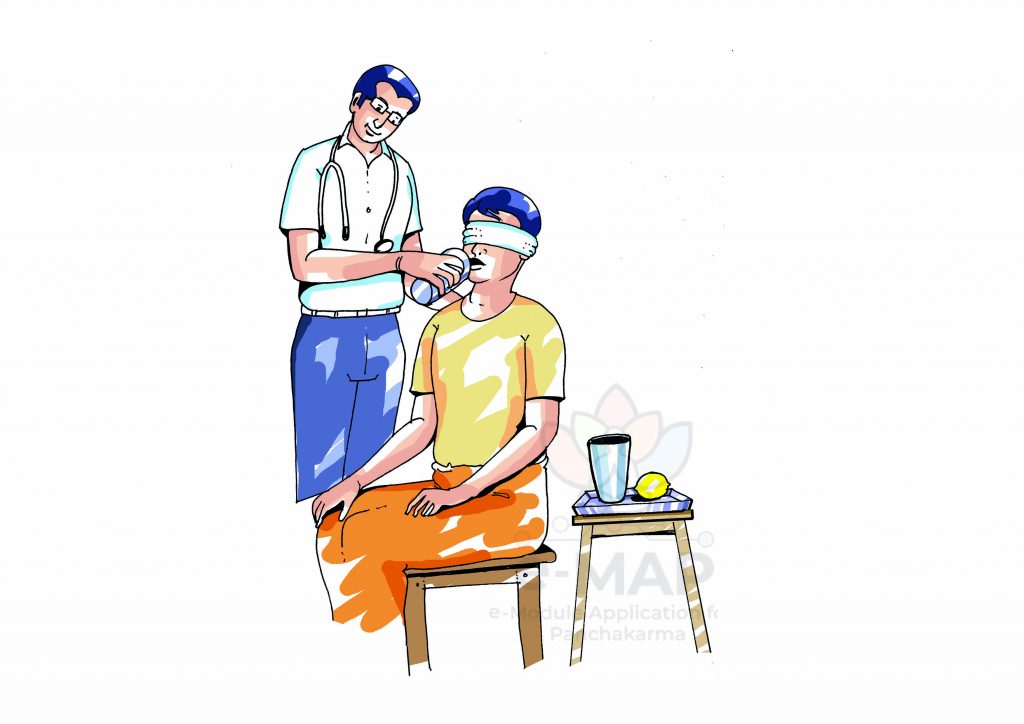
Basic Module 2 - Lesson 18
SNEHANA

EXPLANATORY NOTES
PUṬAPĀKA:
In puṭapāka procedure and indication are same like that of Tarpaṇa but the method of preparation here is different (i.e. the medicine svarasa is extracted by puṭapāka vidhi)
Types:
Depending upon action, Puṭapāka vidhis are of 3 types.
- Snehana b. Lekhana c. Ropaṇa
According to vagbhata:
- Snehana b. Lekhana c. Prasādana
Puṭapākakāla
Ropaṇapuṭapāka = 300 mātrākāla
Snehana puṭapāka = 200 mātrākāla
Lekhana puṭapāka 100 mātrākāla
(1 mātrā-the period of time required for winking the eyelids once)
Method of preparation:
Anūpamāṃsa, vasā, majjā, kākolyādi varga dravyas are used. This medicines are grinded, bolus should be prepared and has to cover with vāta hara patras, then it should be covered with layers of vāluka make it dry under sunlight. Next it should be heated (puṭapāka) svarasa should be extracted and used .
Method of administration:
Instilling a few drops of svarasa into the conjunctival sac through kanīnikā sandhi from a distance of 2 Aṅgula. Remaining procedure same as that of tarpaṇa vidhi.
Indication:
Snehana puṭapāka- Vātaja netrarogas
Lekhana puṭapāka- Kaphaja netrarogas
Ropaṇapuṭapāka Pittaja and Raktaja netrarogas.
Duration:
one day -kaphaja netra rogas
two days -pittaja netra rogas
three days – vātaja netra rogas
ĀŚCOTANA
According to vagbhata the first line of treatment is in occular inflammatory conditions like ruk, toda, kaṇḍu, aśru srāva, śopha etc..
Method of administration:
The patient has to lie Supine position in a room devoid of wind. Now a piece of cloth make as varti soaked in the medicinal liquid is held two fingers above his/her right eye and the other eye is closed and the cloth piece is squeezed and medicinal drops are put into the kanīnaka Sandhi (inner canthus). 10 or 12 drops will be sufficient. After that the same procedure is repeated in the left eye. Then both eyes are cleaned with a soft cloth .
In Vāta & Kaphaja netra rogas it must be hot
Pittaja & Rakthaja netra rogas it must be cold.
Āścotana mātrā :
Snehana- 10 drops, (for vāta vikāras)
Ropaṇa-12 drops (for pitta& rakta vikāras)
Lekhana- 8 drops (kaphaja vikāras)
AÑJANA:
Añjana should be applied after purification of the body and when the dosas are localised exclusively in the eyes. Application of medicine to the internal surface of lid margin from kanīnaka sandhi to apāṅga sandhi, with help of añjana śalāka is known as añjana.
Types:
According to vagbhata:
- Lekhana
b.Ropaṇa
- Dṛṣṭiprasādana
On the basis of ākṛti (nature of drug):
- Guṭikā (varti)
- Rasakriyā
- Cūrṇa
On the basis of quality of añjana
- Tīkṣṇa
- Mṛdu añjana
Añjana vidhi:
After maṅgalācaraṇa and devata prārthana. The patient is asked to sit or in supine position. Physician with his left hand open patient’s eye and with his right hand handle the añjana śalāka and has to do añjana from kanīnikā sandhi to apāṅga sandhi. After añjana application, ask the patient to close his eyes, rotate eyeball gently, eyelids slowly. The eyes should be cleaned when discharge stops.
Indication:
Añjana purifies and removes excess kapha from the eyes. It vision, nourishes eyelashes and brings clarity to the eyes.
Contraindication :
Conditions like udāvarta, krodha, bhaya jvara, pipāsā
Time for añjana application:
Morning and evening are the best time for the application of añjana. when it is not cloudy and the sun is shining.
It should not be applied during the night, after sleep and at midday when strong rays of the sun fatigue the eyes.



